藝術議題
- 藝術與公義最新的專題文章如下。如欲閱讀有關同一議題的其他文章,可再點擊右下角資料庫的年份和月份。
Manila 馬尼拉
約翰百德 (John BATTEN)
at 2:41pm on 9th February 2025
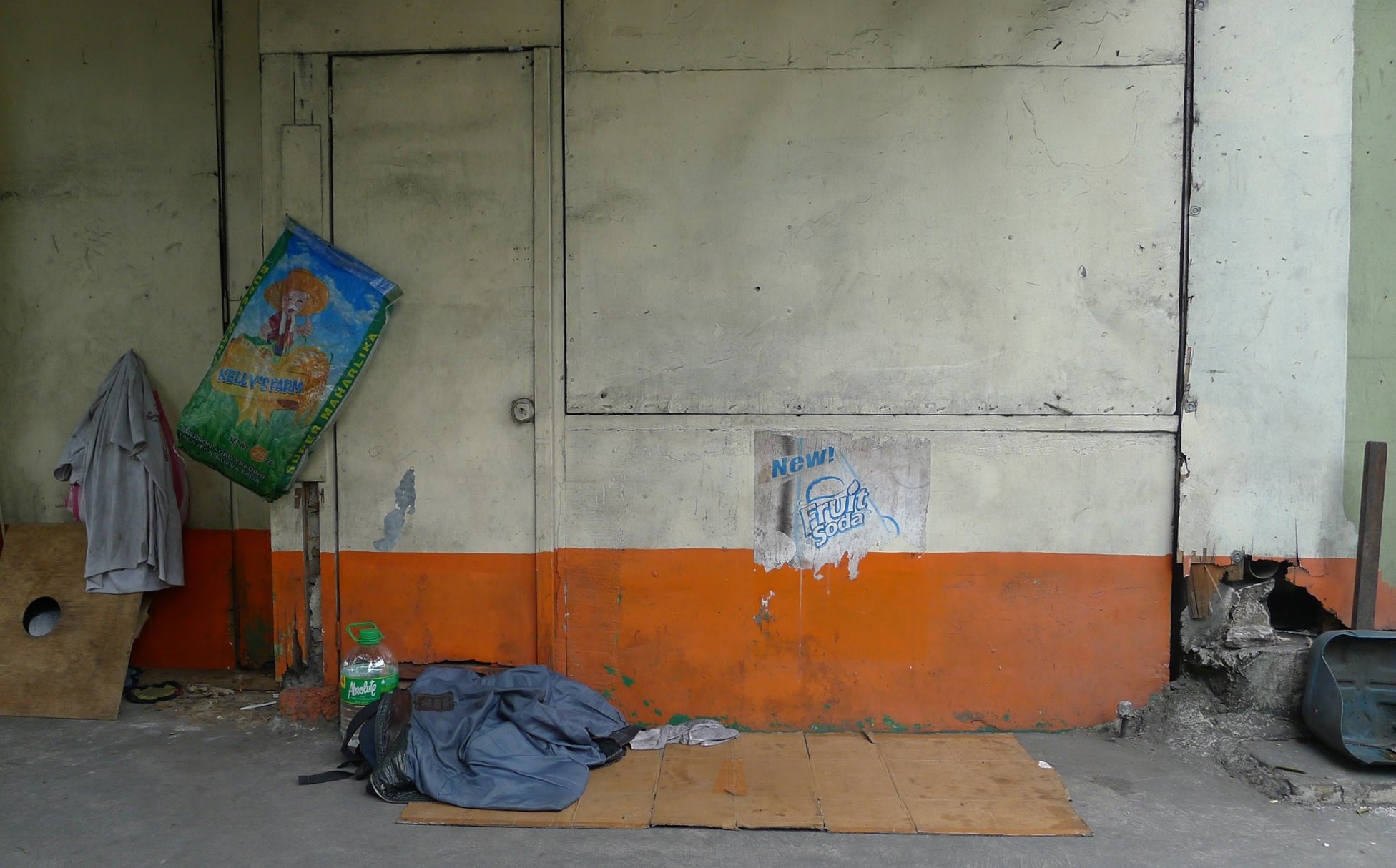
圖片說名 Above image:
2018年11月30日,馬尼拉帕高的街頭瓦通紙皮「床」和家當。 (照片由作者提供
Street-side cardboard ‘bed’ and possessions, Paco, Manila, 30 November 2018. (photograph: John Batten)
(Originally published in Hong Kong's Ming Pao Weekly in November 2018, this article written by John Batten might indicate the future of populist political leaders who try to overturn the norms of society and its institutions - in English & Chinese: scroll down for English text).
前言 (9/2/2025):
自美國總統特朗普上任滿一周以來,我想起了同樣民粹主義的菲律賓前總統杜特爾特及其試圖瓦解國家制度的行為。這裏有兩位相似的男人,他們的結局或許會相似。
2018年,我撰寫了一篇有關馬尼拉城市發展的短評。當時,菲律賓總統杜特爾特正嚴厲打擊毒販,以進一步推進他的反毒之戰(war on drugs)計劃。然而,他處理毒販的手法極為武斷,杜特爾特甚至利用「死亡小隊(death squads)」來處決當年反對其血腥執政的市民、記者和政治家。國際刑事法院至今仍在持續調查「反毒之戰」所引發的人權問題。
此後,小名「邦邦(Bongbong)」的馬可斯(Ferdinand Marcos)之子小馬可斯在2022年當選菲律賓總統,而杜特爾特的女兒莎拉(Sara Duterte)則當選副總統。自那時起,因莎拉父親的影響,他們二人的政治及個人關係出現了政治內爆(political implosion)。
更具爭議的是,莎拉最近公開威脅小馬可斯,聲稱如果她遭到暗殺,將會有刺客來刺殺小馬可斯。菲律賓國會目前正就此事件對莎拉進行彈劾。這篇2018年的文章恰好預示了杜特爾特當年執政所留下的隱患。
Update 11/3/2025: Duterte arrested in Manila - see: Duterte arrest
馬尼拉
撰文:約翰百德
過去三十年來,我到過馬尼拉的無數次,大部份都和藝術相關,好像探望藝術家朋友、參觀和舉辦展覽與活動等。我早已習慣了這個城市的吵鬧、交通、塵土飛揚的道路、脆弱的基建和貧窮,我看過整家人露宿街頭,睡在以瓦通紙皮搭建的地方,也慣了自己面對以上種種時令人尷尬的反應:提高警覺,慎防扒手、攔途搶劫或掠奪者;連馬尼拉居民也不會掉以輕心的警覺。對,像我這樣一個白種男人走在街上,又或坐在吉普尼車上,我的確「鶴立雞群」,但我到訪馬尼拉這麼多次,什麼事也沒有發生過。相反,我試過在一些「安全」的城市被小偷埋手,好像西班牙的巴塞隆納和中國的大理。馬尼拉的街道熙來攘往–有小童、學生、長者、忙著工作的人;這些街道和香港的大同小異。人多擠迫的街道通常都是安全的街道。
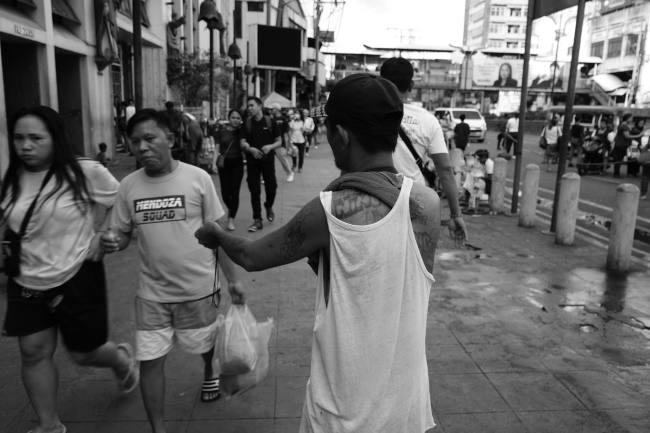
Street vendor selling rosary beads outside Quiapo church, Manila, 2023 (photo: John Batten)
然而,在最近一次旅程中,我感到小型地動正在發生,預示著更大的震盪即將到來。
市內隨處可見的,是狂亂、近乎失控的建築:高聳的分層公寓、閃閃發亮的賭場、以中文和韓文寫成的新招牌,還有建於廣闊填海用地上的新建辦公大樓和國際風酒店(大部份都方便地位處鄰近機場的地方)。這些都是經濟正蓬勃發展的跡像。
可是,要認識馬尼拉正在發生的轉變,只要看看街上情況便可知一二。幾乎什麼也沒有改變過,什麼也沒有演進過,什麼也沒有改善過。儘管財富與資金都湧向為新建大廈融資,城中街道卻反映了這裡缺乏改變。在過去30年,沒有多少投資落在改善馬尼拉的基建上。道路延長加闊的工程絕無僅有;市內沒有新建多少行車天橋來紓緩十字路口的擠塞情況;只要小雨一場路面便會氾濫。與此同時,越來越多的車輛每天溜進街上,部份路面可以數小時寸步不進。
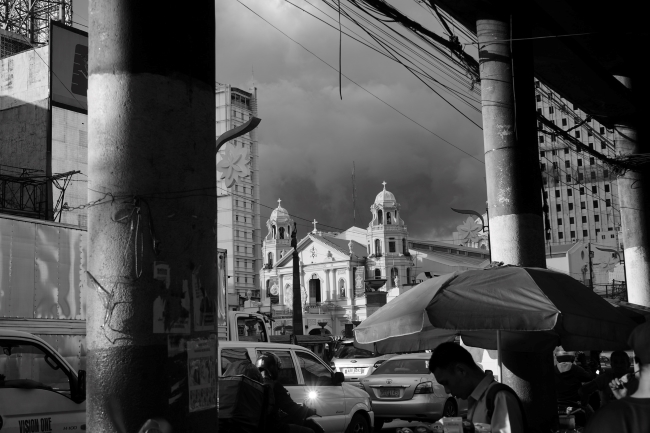
Traffic-jammed roads passing Quiapo church, Manila, 2023 (photo: John Batten)
私家車這種最沒有效率的交通型式卻在馬尼拉急劇增加。對於中產階級來說,坐在自己的私人空間裡塞車數小時,總勝過在吉普尼上吸入令人噁心的柴油廢氣,或在城中唯一一個公共火車系統中排在無止境的隊裡購票,再排另一條隊等著迫上吱嘎作響、資金投入不足的架空輕軌和地鐵列車。對大部份馬尼拉居民來說,每天通勤都是漫長、炎熱和非常不舒服的旅程。假如決策者可以真的做決定,只要引入專營巴士線和在路面設置巴士站,像雅加達已成功推行的模式,便可即時緩解上班族的苦況。
直至不久以前,城裡多片空地本來為以鐵皮、碎木材和膠片搭建的非正規棚屋提供額外空間,但這些地方上的寮屋已被逐一清拆,地皮正進行或即將進行發展。殖民時代的馬尼拉設有河流和運河組成的水道網絡(稱為 esteros),規模媲美曼谷;像曼谷一樣,很多水道已被填平,由道路取代。沿著市內僅餘水道旁邊的是多個非正式小區,建有搖搖欲墜的房子,隨時會被水浸和颱風催毀,但卻住上數以千計的人。
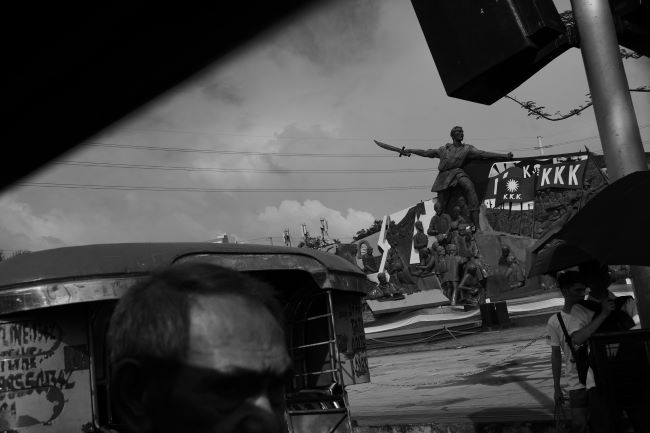
The KKK statue photographed from a jeepney, Rizal Park, Manila, 2023
(see details about the revolutionary Katipunan, or KKK photo: John Batten)
市內有不少貧困人民,包括接受最低工資的在職貧窮人口,但為他們而設的可負擔房屋卻嚴重短缺,因此城中老區、墳場、天橋底、貨櫃碼頭附近和橫街窄巷之間,常常看到這些非正規房屋。
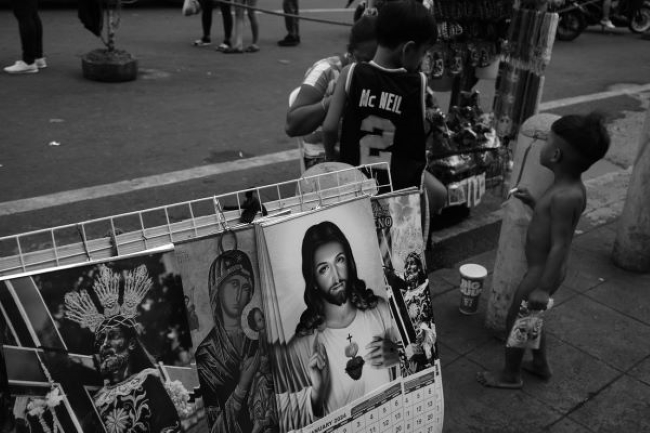
Children on the street, near Quiapo church, Manila, 2023 (photo: John Batten)
城市新建的分層公寓高樓是為售予海外投資者、非本地居民和新移民而建,包括那些申請菲國投資簽證居留計劃的中國人。菲律賓所急切需要的,卻是價格相宜的大眾住房。她急需香港(現在)習以為常的那種公共房屋。私人建造的分層公寓也許可以吸引資金,但住屋的公共投資卻可提供清潔、安全的住宿,這才是一個健康、生氣勃勃的國家所必須的。
地動正在蘊釀:它在菲律賓總統杜特爾特毒品「戰」法外處決言論的反對聲音中輕語;在反對中國房地產新業主的意見中聽得到;在另一名記者被殺害時聽得到;在交通擠塞中聽得到;在乞丐伸出雙手叫化時聽得到;在街頭紙皮床之間聽得到;在教堂講壇裡慶祝耶穌誕生之間,在叫喚 「你要愛鄰人,像愛自己一樣」裡聽得到。
參考短片:
Lino Brocka:《馬尼拉:在霓虹燈的魔爪下》(1975) - see clip on Youtube
Carlo Gabuco:《以父之名》(2016) – 見: vimeo.com/197068241
Philippine director Lav Diaz's films on Duterte's "war" on drugs:
When the Waves are Gone (2022)
Essential Truths of the Lake (2023)
Preface 9/2/2025:
After Donald Trump's first weeks in office as U.S. President, I recalled the similarly populist Rodrigo Duterte of The Philippines and his attempts to dismantle that country's institutions - there are similarities with these two men and possibly similar outcomes. I wrote this short opinion piece in 2018 about Manila's urban problems and the discord in the Philippines as then-President Rodrigo Duterte was expanding his "war" on drugs and drug-dealers. But, identifying a drug-dealer was arbitrary and Duterte was accused of using "death squads" to also target the general public, journalists and political opponents. The International Criminal Court has an on-going investigation into these alleged crimes against humanity committed during the Philippines drug war.
Since then, Ferdinand Marcos Jr commonly known as Bongbong, the son of Philippine's former President, the dictatorial Ferdinand Marcos, ran and won the 2022 Philippine Presidential election with Sara Duterte - the daughter of Rodrigo Duterte - as his Vice-President running-mate. Since the election, their political and personal relationship has imploded over policy issues and as a consequence of her father's legacy.
Controversially, Sara Duterte recently threatened Marcos with assassination by hired hit-men, if she herself was ever to be assassinated. The Philippine Congress has now impeached Sara Duterte. This 2018 article is somewhat prescient of the consequences of Duterte's years in office.
Update 11/3/2025: Update 11/3/2025: Duterte arrested in Manila - see: Duterte arrest
'Manila'
by John Batten
I have visited Manila on countless occasions over the last thirty years, mostly related to art (visiting artist friends, seeing and organizing art exhibitions and activities). I am accustomed to the city’s noise, traffic, dusty roads, fragile infrastructure, the poverty, of seeing entire families sleeping on the street on scraps of cardboard, and of my embarrassed reaction to all this: the need to be aware of a pick-pocket, mugger or snatcher. It is a precaution that Manila residents themselves take. Yeah, I ''stick-out in the crowd’, a white man walking on the street, or, riding in a jeepney, but nothing has ever happened in the past to me in Manila. Whereas, I have been struck by thieves in the ‘safer’ cities of Barcelona (Spain) and Dali (China). Manila’s streets are crowded – with children, students, the elderly, people busy working; streets not much different from Hong Kong’s. Crowded streets are usually safe streets.

Street vendor selling rosary beads outside Quiapo church, Manila, 2023 (photo: John Batten)
However, on my most recent trip, I felt a small earthquake rumbling; rumbling for a bigger earthquake.
Seen throughout the city is frantic, almost-uncontrolled construction: the high-rise condominiums, the glittering casinos, new signage in Chinese and Korean, and acres of newly-built offices and international-style hotels on reclaimed land, much of it conveniently located near the airport. It could be a sign of a booming economy.
However, to know the changes happening in Manila, look no further than the streets. Almost nothing has changed, nothing has evolved, nothing has improved. Despite the influx of wealth and capital to finance the construction of new buildings, the streets reflect the city’s lack of change. In the last thirty years, there has been little investment to improve Manila’s infrastructure. The roads have hardly been extended or widened, few flyovers have been built to ease intersection congestion, and the roads flood even in a slight rain. Meanwhile, more and more cars roll onto the roads every day. Some roads are grid-locked for hours.

Traffic-jammed roads passing Quiapo church, Manila, 2023 (photo: John Batten)
That most inefficient form of transport, the private car, proliferates in Manila. For the middle-class, having your own private space sitting in an hours-long traffic jam is considered preferable than sitting in a jeepney breathing nauseous diesel fumes, or, waiting in line, interminably, just to buy a ticket and then waiting in another line to board the city’s sole public train systems, the creaky, under-capitalized, elevated LRT and MRT. For most Manila residents the daily commute is a long, hot, highly uncomfortable journey. Introducing dedicated bus-lanes and on-road bus stations, as has been successfully done in Jakarta, would, if decision-makers could ever actually make a decision, bring immediate relief for city commuters.

The KKK statue photographed from a jeepney, Rizal Park, Manila, 2023
(see details about the revolutionary Katipunan, or KKK photo: John Batten)
Pockets of the city’s vacant land that had until recently provided extra space for informal shanty housing made of corrugated iron, timber off-cuts and plastic sheeting have been cleared of squatters (or ‘informal settlers’) and are undergoing or awaiting development. Colonial Manila had a network of rivers and canals (known as esteros) that rivalled Bangkok; and like in Bangkok many have been filled-in, replaced by roadways. Along the edges of the city’s remaining esteros are informal settlements, rickety homes subject to flooding and the threat of typhoons. These are homes for tens of thousands of people.

Children on the street, near Quiapo church, Manila, 2023 (photo: John Batten)
A desperate shortage of affordable housing for the city’s poor, including the working poor on minimum wages, see such informal housing throughout the older parts of the city, in cemeteries, under flyovers, around the city’s container and port area and on back streets and lanes.
The city’s new high-rise condominiums are built for sale to overseas investors, non-residents, and newly arrived immigrants, including from China, who have applied under the country’s investment visa residency schemes. The Philippines, however, urgently needs low-cost mass-housing. It urgently needs the sort of public housing that we (now) take for granted in Hong Kong. Privately-built condominiums may attract capital, but public investment in housing offers clean, safe accommodation that is so necessary for a healthy, vibrant nation.
An earthquake is brewing. It’s heard muttered against the extra-judicial killings of Philippine President Duterte’s ‘war’ on drugs. It’s heard against new Chinese property owners. It’s heard when another journalist is murdered. It’s heard just sitting in a traffic jam. It’s heard when beggars out-stretch their hands. It’s heard on street-side cardboard beds. It’s heard in the church pulpits to celebrate Jesus Christ’s birth and alongside the shouts of “You shall love your neighbor as yourself.”
Further viewing:
Philippine film director Lino Brocka's exploration of the tough urban reality of life in Manila:
Manila in the Claws of Light (1975) - see clip on Youtube
Carlo Gabuco, In the name of the Father (2016) – photograph slideshow of extra-judicial killings of Philippine President Duterte’s ‘war’ on drugs: vimeo.com/197068241
Philippine director Lav Diaz's films on Duterte's "war" on drugs:
When the Waves are Gone (2022)
Essential Truths of the Lake (2023)
